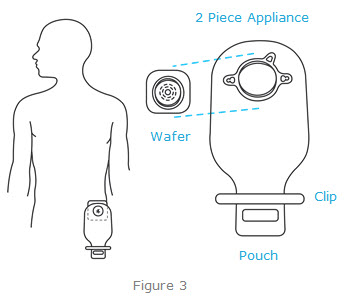A Guide to Ileostomies | Overview
What is an ostomy?
- An ostomy is a surgically-created opening in the intestine (bowel). The opening is called a stoma. The opening is made through the abdomen (belly).
- When someone has an ostomy, body waste from the intestine, such as stool (poop), passes through the stoma and out of the belly instead of the anus.
- The most common types of ostomies are ileostomies and colostomies. The type your child will have depends on where the opening is made in the intestine. A surgeon and nurse will talk to you about the type of ostomy your child needs.
Why is it necessary?
- Ostomies are used to get around a diseased, damaged or blocked part of the intestine. Ostomies might also be done above an area of intestine that is healing after an operation.
- Ostomies can help prevent a disease, illness or a blockage from becoming more serious.
- Your child may need an ostomy due to necrotizing enterocolitis, Hirschsprung’s disease, problems with the anus or rectum or inflammatory bowel disease (such as ulcerative colitis and Crohn’s disease).
How does it work?
In order to understand ostomies, it’s helpful to understand how digestion works.
- The gastrointestinal (GI) system breaks down food into basic nutrients that feed the cells of the body.
- When food is chewed and swallowed, it goes down the esophagus (food tube) into the stomach.
- Digestion begins in the stomach. Food is broken down into a liquid mixture.
- Next, the liquid food mixture travels to the small intestine. The duodenum, jejunum and ileum are parts of the small intestine.
The small intestine is where most digestion takes place. Vitamins, minerals, proteins, fats and carbohydrates get absorbed into the body.
- Food travels into the large intestine as liquid waste.
- The large intestine is also called the colon. The ascending, transverse, descending sigmoid and rectum are parts of the large intestine.
- In the large intestine, water is absorbed and undigested food becomes body waste.
- The waste is stored in the large intestine until it passes out of the body.

What is an ileostomy?

- An ileostomy is a surgical opening in the small intestine (ileum).
- An end of the ileum is brought out to the surface of the belly and stitched in place.
- The stool that comes out of an ileostomy stoma flows out continuously and is usually water. It can be irritating to the skin around the opening
What is a colostomy?
- A colostomy is a surgical opening in the large intestine.
- An area of the colon is brought out to the surface of the belly and stitched in place.
- With a colostomy, there is a thicker, pastier stool than an ileostomy. How thick the stool is depends on where in the colon the colostomy is created. For example, a colostomy at the beginning of the colon has looser stool. The reason is that it does not travel through the entire colon where water gets absorbed to make the stool thicker.
How do I take care of an ostomy?
- Your child will need to wear a pouch or bag. The pouch collects the stool.
- Care of an ostomy includes emptying the pouch, changing the pouch and cleaning the stoma area.
- Pouches need to be emptied several times a day, depending on the amount of stool in the pouch. It’s important to empty the pouch when it is about one-third full or less. When a pouch gets too full, it may leak.
- At home, change the pouch every two to four days, or as needed. If you have an infant, the pouch can be changed daily. Pouches for newborns can be removed more easily without damaging the skin.
- The nursing staff will teach you how to care for the ostomy and how to change the pouch.
Can my child be active?
- Your doctor or nurse will talk with you about what activities are safe for the first four to six weeks after surgery.
- After that time, your child should be able to do most activities, like swimming, showering and going to the beach. Infants can lie on the stoma.
- Rough contact sports like football or wrestling usually are not allowed. Check with your child’s doctor or nurse if you have questions.
What can my child eat?
- Your child should be able to eat and drink most foods.
- It’s important for your child to eat and drink the right amounts of certain foods. Your child’s nurse will go over the “Ostomy Diet Guidelines Family Education Sheet” with you.
- If your child has an ileostomy, it’s very important for her to drink lots of liquids, like formula, milk and juices, to avoid getting dehydrated. These liquids are better than water or soda.
- Your child should not have certain things that cause gas in the pouch. Do not give your child carbonated drinks (like soda), straws or chewing gum.
What supplies do I need?
- Several medical equipment supply companies will deliver ostomy supplies directly to your home.
- A discharge-planning nurse from Boston Children’s Hospital will contact a supply company to order what you need. The supply company that is used usually depends on where you live and the type of health insurance that you have. The nurse will also set up a very important follow-up visit.
- After the first delivery, you can contact the company directly for more supplies. Be sure to plan ahead so you do not run out.
- A nurse from Boston Children’s will arrange for a visiting nurse to come to your home. The visiting nurse will help you and answer any questions you may have.
Important tip: Always carry an extra pre-cut pouch in case a pouch leaks when you are not at home. Download the PDF.
